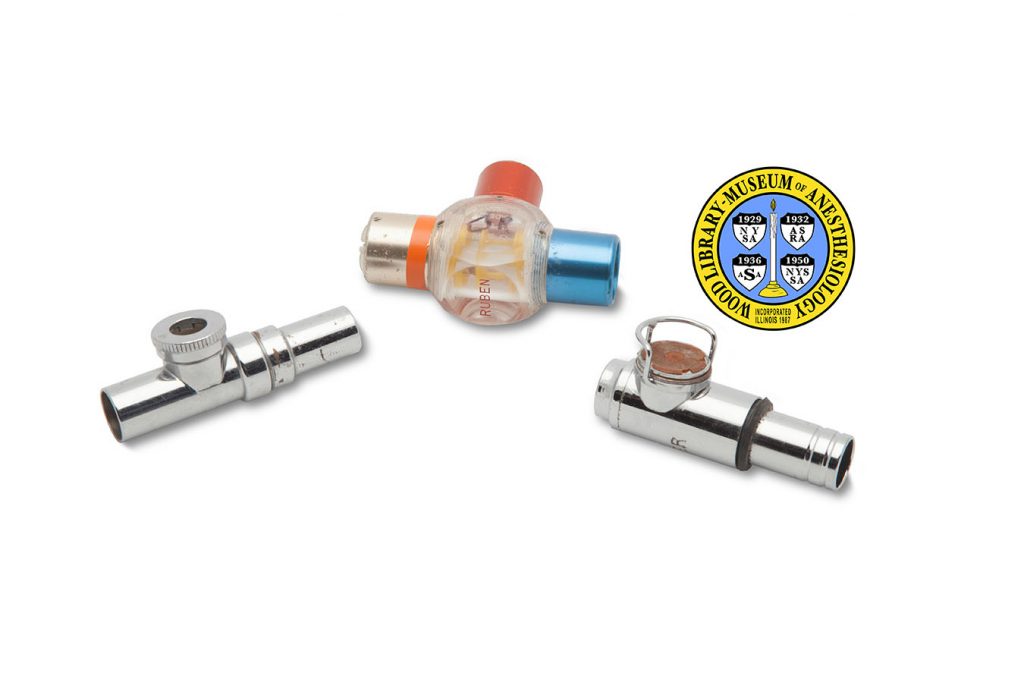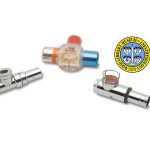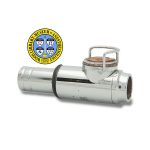Nonrebreathing Valves
Children and neurosurgical patients are particularly at risk of complications caused by a build-up of carbon dioxide (CO2) through rebreathing their own exhaled air during general anesthesia. Nonrebreathing valves are one way to minimize this. The three shown here are, from left to right, the Leigh, Ruben, and Stephen-Slater valves.
Each contains internal valves to control the direction of air flow during inspiration and expiration. Unlike closed circuit systems, these require that air pressure be controlled manually. They are designed to connect at one end to an endotracheal tube, and at the other to a reservoir bag. The bag could also be used for artificial respiration if needed. The anesthesiologist had to estimate the volume of gas or air delivered when his or her hand squeezed the bag.
Catalog Record: Nonrebreathing Valves Three Catalog Records: The Leigh Valve (akii), the Ruben Valve (akij), and the Stephen Slater valve (akik).
Access Key: akii
Accession No.: 2003-08-04-1 I
Title: [Leigh valve] / designed by M. Digby Leigh.
Author: Leigh, M. Digby, 1904-1975.
Title variation: Alt Title
Title: Leigh’s nonrebreathing valve.
Title variation: Alt Title
Title: Leigh nonrebreathing valve.
Title variation: Alt Title
Title: Digby Leigh valve.
Publisher: [New York] : Foregger, [1947-1980].
Physical Descript: 1 nonrebreathing valve : metal, plastic ; 3 x 2.5 x 8 cm.
Subject: Nonrebreathing Valves.
Subject: Anesthesia, Pediatric.
Note Type: General
Notes: First year in date range based on the date (1947) an article in which the
valve was described was submitted for publication (June 11, 1947). The
article is “Endotracheal Anesthesia for Operations on Cleft Lip and Cleft
Palate,” by Dr. Leigh and Dr. Kester (1948). Two resources (Brown, 2011 ;
Smith, 1959) describe the original Leigh valve as employing metal discs for
the inspiratory and expiratory valves. The example described in this record
contains clear plastic discs. These may be original to the valve. If so, this
valve would not have been manufactured as early at 1947. Additionally the
discs contained in this valve may have been replacements for original metal
or plastic discs. For this reason we have not ruled out an early manufacture
date. The end date in the range of years for the possible year of manufacture
is generously based on the date of a Foregger catalog in which the valve is
still listed (1976). The date range could change if documentation indicates
the range should be corrected.
Note Type: General
Notes: Title from the manufactuer’s 1949 catalog.
Note Type: Citation
Notes: Anesthesia equipment: connectors, adapters & valves. [Allentown, PA]: Air
Products and Chemicals, Inc.;1976.
Note Type: Citation
Notes: Brown TCK. Vignette: Digby Leigh. Paediatr Anaesth. 2011;21(11):1148-1149.
Note Type: Citation
Notes: Dunbar BS, Andropoulos DB. History of pediatric anesthesia. In: Gregory GA,
Andropoulos DB, eds. Gregory’s Pediatric Anesthesia. 5th ed. Chichester, West
Sussex: Wiley-Blackwell; 2012:17-19.
Note Type: Citation
Notes: Leigh MD, Belton MK. Inhalation anesthesia. Pediatric Anesthesia. New York:
Macmillan, 1948.
Note Type: Citation
Notes: Leigh MD, Kester HA. Endotracheal anesthesia for operations on cleft lip and
cleft palate. Anesthesiology. January, 1948;9(1):36-37.
Note Type: Citation
Notes: Smith RM. Equipment. Anesthesia for Infants and Children. St. Louis: C.V.
Mosby Company; 1959:88.
Note Type: Citation
Notes: Steen SN, Chen JL. Automatic non-rebreathing valve circuits: some principles
and modifications. Brit J Anaesth. 1963;35(6):379.
Note Type: Citation
Notes: Stephen CR. History of Canadian Anaesthesia: M. Digby Leigh (1904-1975). Can
J Anaesth. 1992;39(8):892.
Note Type: Citation
Notes: Tashiro M, Waki I. An automatic nonrebreathing valve of new design.
Anesthesiology. 1963;26(2):232.
Note Type: Physical Description
Notes: One metal nonrebreathing valve; One end has a diameter of approximately 1.7
cm; This end is the inlet for fresh gas; The other end has a diameter of
approximately 1.5 cm; This end would be attached to the patient’s
endotracheal tube; Within the tube is the inhalation valve; A short tubular
extension exits the side of the valve, near the inlet; This extension holds
the exhalation valve; The extension is topped by a screw on cap that is
hollow at the center; The plastic disk for the exhalation valve is visible
through the cap; The text, “FOREGGER” is engraved on the exterior of the
valve by the manufacturer; The exterior is worn with scratches.
Note Type: Reproduction
Notes: Photographed by Mr. Steve Donisch on January 16, 2013, with two other
nonrebreathing valves: the Ruben nonrebreathing valve(akij), and the
Stephen-Slater nonrebreathing valves (akik).
Note Type: Acquisition
Notes: Donated to the WLM by Ray T. Smith, MD.
Note Type: Historical
Notes: During the 1940s rebreathing respiratory systems employing carbon dioxide
(CO2) absorption were being used during anesthesia for adults. These systems
conserved anesthetic as well as the warmth and moisture in the patient’s
exhaled breath. For infants and children, safe rebreathing systems had yet to
be developed, and the open drop method with a mask was still common. However,
open drop anesthesia did not support extensive surgery of the face, such as
surgery for cleft palate, so anesthesiologists were working on systems that
employed an endotracheal tube connected to a constant supply of fresh
anesthetic and oxygen. For a number of reasons, pediatric anesthesiologists
needed to be especially careful to ensure that their small patients
effectively breathed and eliminated carbon dioxide during anesthesia.
Note Type: Historical
Notes: Dr. M. Digby Leigh (1904-1975) developed the valve described here to prevent
patients from rebreathing the CO2 in the gas they exhaled, hence the term
‘nonrebreathing’ valve. The metal housing actually contains two valves; one
directed only fresh gas into the patient’s endotracheal tube during
inhalation, and the other directed exhaled breath away from the patient into
the room air. One end of the Leigh Valve was attached to the patient’s
endotracheal tube, and the other end was attached to the reservoir bag that
contained fresh gas flowing from the anesthesia machine. The opening for the
exhalation valve is on the side. Dr. Leigh’s valve had to be kept upright in
order to function properly. Also, when providing assisted ventilation (by
squeezing the reservoir bag with one hand), the anesthesiologist had to
occlude the expiratory valve using the other hand. These requirements were
considerably inconvenient, and in some circumstances impractical, but despite
these, and a few other imperfections, other anesthesiologists saw the benefit
of having a well-functioning nonrebreathing valve and began to think about
and develop their own.
Note Type: Historical
Notes: Digby Leigh, MD was a pioneer in pediatric anesthesia. Born in the UK and
raised in British Columbia he earned his medical degree at McGill University
in Montreal, and from 1936 to 1939 completed an anesthesia residency at the
University of Wisconsin under Ralph Waters. Among his numerous
accomplishments is the publication of one of the earliest comprehensive
textbooks on pediatric anesthesia, written with his colleague Dr. Kay Belton.
First published in 1948, “Pediatric Anesthesia” remained one of the primary
texts on the subject for nearly 30 years.
Note Type: Publication
Notes: Neff WB. The Wisconsin-California connection. Anesth Hist Assoc Newsl.
1986;4(3):1,4-7.
Note Type: Publication
Notes: Conn AW. Origins of paediatric anaesthesia in Canada. Anesth Hist Assoc Newsl
1993;11(3):1, 4-8.
Note Type: Exhibition
Notes: Chosen for the WLM website (noted July 30, 2013).
Access Key: akij
Accession No.: 1991-12-10-1 D
Title: Ruben [nonrebreathing valve / designed by Henning Ruben].
Author: Ruben, Henning M. (Moritz), 1914-2004.
Title variation: Alt Title
Title: Ruben valve.
Publisher: Denmark : S & W, [1956-1980].
Physical Descript: 1 nonrebreathing valve : metal, plastics, silicone ; 8 x 3 x 6 cm.
Subject: Nonrebreathing Valves.
Subject: Anesthesia, Pediatric.
Subject: Neuroanesthesia – instrumentation.
Note Type: General
Notes: Date range for the possible year of manufacture based on the year that Dr.
Ruben first described his valve in an English language publication (1955).
The late date for the possible year of manufacture is based on the amount of
wear to the valve and the donation date (it was donated in 1991 and the valve
shows enough wear to suggest that it was used for at least 10 years, thus the
end date of 1980).
Note Type: General
Notes: The manufacturer’s mark, “S & W”, likely stands for the Danish manufacturer
Simonsen & Weel. By 2005 they no longer manufactured the Ruben Valve.
Note Type: Citation
Notes: Basket P, Zorab J. Henning Ruben MD, FFARCS(I), FFARCS: the Ruben valve and
the AMBU bag. Resuscitation. 2003;56(2):123-127.
Note Type: Citation
Notes: Berthelsen PG, Hazholdt OS, Mogensen JV. Henning Moritz Ruben in memoriam
(1914-2004). Acta Anaesthesiol Scand. 2005;49(8):1056.
Note Type: Citation
Notes: Maltby JR. Ruben Valve: Henning Ruben (1914- ). In: Maltby JR, ed. Notable
Names in Anaesthesia. London: Royal Society of Medicine Press; 2002:184-186
Note Type: Citation
Notes: Ruben H. Anesthesia and resuscitation equipment I happened to be involved
with. In: Rupreht J, Jan van Lieburg M, Lee JA, Erdmann W, eds. Anaesthesia:
Essays on Its History. Berlin: Springer-Verlag; 1985:65-68.
Note Type: Citation
Notes: Ruben H. A new nonrebreathing valve. Anesthesiology. 1955;16(4):643-645.
Note Type: Physical Description
Notes: One nonrebreathing valve in which the central portion is transparent; The
metal connections, cylindrical shape, for the fresh gas and to the patient,
as well as the expiratory valve, are painted different colors; The blue inlet
has an external diameter of approximately 2.2 cm; The red connection for the
patient’s endotracheal tube or mask has an internal diameter of about 1.6 cm,
and an external diameter of 2.2 cm; The outlet for exhaled breath is light
gold in color; A thin piece of orange tape is on the gold outlet; Inside the
central transparent portion the bobbin and other valve parts are yellow in
color; The manufacture’s marks are on the transparent portion and include,
“RUBEN” in red letters; A different side of the transparent center is marked
with, “S & W [new line] Pat. [new line] MADE IN [new line] DENMARK”;
Handwritten over the “Pat.” in permanent ink is, “OR”; The paint on all
connections is worn and has numerous small scratches.
Note Type: Reproduction
Notes: Photographed by Mr. Steve Donisch on January 16, 2013, with two other
nonrebreathing valves: the Leigh nonrebreathing valve (akii), and the
Stephen-Slater valve (akik).
Note Type: Acquisition
Notes: Donated to the WLM by Kenneth Noel, MD.
Note Type: Historical
Notes: Danish anesthesiologist and dentist Dr. Henning Ruben may be best known as
the inventor of the self-inflating bag (used to help patients breathe) and
the eponymous nonrebreathing valve described here. But others knew him as a
professional dancer, a medal winning fencer, and a professionally recognized
magician. ‘Dexterous problem solver’ can also be added to that list. Time
and again Dr. Ruben responded to challenges with uncommon ingenuity.
When unable to quickly acquire the new Stephen-Slater Nonrebreathing Valve,
Ruben set out to fashion one for himself. In the process, he came up with a
new design, one that solved a drawback of both the Stephen-Slater and Leigh
Valves. The Ruben mechanisms automatically closed the expiratory valve when
the anesthesiologist squeezed the reservoir bag to help the patient breathe.
This freed one hand for other important tasks, such as checking the patient’s
pulse, administering medication, or adjusting the flow of oxygen or
anesthetic gas. The valve also included an adjustable “blow-off” or pressure
limiting function. This safety feature was included to prevent the
overinflation of the patient’s lungs.
The Ruben Valve was initially introduced in Denmark in 1950. In 1954, the
improved, second version was introduced in Denmark. Anesthesiologists in the
US learned of the valve when it was described in the journal “Anesthesiology”
in 1955. Notably, the Ambu Valve, which is currently found in operating
rooms, recovery rooms, critical care units, emergency rooms and ambulances
worldwide, was based on another design by Dr. Ruben.
Note Type: Exhibition
Notes: Chosen for the WLM website (noted July 30, 2013).
Access Key: akik
Accession No.: 2001-12-27-1 H
Title: [Stephen Slater valve / designed by C.R. Stephen and H.M. Slater.]
Author: Stephen, C. Ronald (Charles Ronald), 1916-2006.
Author: Slater, Harry M., 1915-1993.
Title variation: Alt Title
Title: Stephen-Slater valve.
Title variation: Alt Title
Title: Stephen-Slater nonrebreathing valve.
Publisher: [New York] : Foregger, [1953-1980].
Physical Descript: 1 nonrebreathing valve : metal, rubber ; 3.5 x 2.5 x 8 cm.
Subject: Nonrebreathing Valves.
Subject: Anesthesia, Pediatric.
Subject: Neuroanesthesia – instrumentation.
Note Type: General
Notes: First year (1953) in date range based on the dates of two Foregger Catalogs.
The 1952 catalog does not have the drapery guard for the the Stephen Slater
valve, but the 1955 catalog does. The end date in the range of years for the
possible year of manufacture is generously based on the date of a Foregger
catalog in which the valve is still listed (1976). The date range could
change if documentation indicates the range should be corrected.
Note Type: General
Notes: Title from the manufactuer’s 1952 catalog.
Note Type: Citation
Notes: Anesthesia equipment: connectors, adapters & valves. [Allentown, PA]: Air
Products and Chemicals, Inc.;1976.
Note Type: Citation
Notes: Catalog No. 11. New York: Foregger Company, Inc.; 1952:112.
Note Type: Citation
Notes: Catalog No. 12. New York: Foregger Company, Inc.; 1955:123.
Note Type: Citation
Notes: Conn AW. Origins of paediatric anesthesia in Canada. Anesth Hist Assoc Newsl.
1993;11(3):1,4-8.
Note Type: Citation
Notes: Dunbar BS, Andropoulos DB. History of pediatric anesthesia. In: Gregory GA,
Andropoulos DB, eds. Gregory’s Pediatric Anesthesia. 5th ed. Chichester, West
Sussex: Wiley-Blackwell; 2012:18.
Note Type: Citation
Notes: Fink BR. A nonrebreathing valve of new design. Anesthesiology. 1954;15(5):471
Note Type: Citation
Notes: In memoriam Ron Stephen. Newsline: McGill Anesth Newsl. Winter, 2007:15.
https://www.mcgill.ca/files/anesthesia/Winter07A.pdf. Accessed August 5, 2013.
Note Type: Citation
Notes: Shephard DAE, Chalklin J, Pope F. An exhibit of inhalers and vaporizers,
1847-1968. Canadian Anesthesiologists’ Society website. https://www.cas.
ca/English/Page/Files/74_Exhibit%20of%20Inhalers.pdf. Published 2003.
Accessed August 5, 2013.
Note Type: Citation
Notes: Smith RM. Equipment. Anesthesia for Infants and Children. St. Louis: C.V.
Mosby Company; 1959:88.
Note Type: Citation
Notes: Stephen CR, Slater HM. A nonresisting, nonrebreathing valve. Anesthesiology.
1948;9(5):550-552.
Note Type: Physical Description
Notes: One metal nonrebreathing valve; One end has a diameter of approximately 1.7
cm; The other end has a diameter of approximately 1.9 cm; The widest diameter
exists between the two ends and is approximately 2.2 cm; Within the tube is
the inhalation valve; A short tubular extension exits the side of the valve,
near the inlet; This extension holds the exhalation valve; The extension is
protected from occlusion by a rail like drapery guard; The rubber portions of
the valve are hardened and deteriorated; The exterior is slightly worn with
scratches; The text, “FOREGGER” is engraved on the exterior of the valve by
the manufacturer; “BRUNER” is scratched onto the valve just below the
manufacturer’s marking.
Note Type: Reproduction
Notes: Photographed by Mr. Steve Donisch on January 16, 2013, with two other
nonrebreathing valves: the Ruben nonrebreathing valve (akij), and the Leigh
nonrebreathing valves (akii).
Note Type: Acquisition
Notes: Donated to the WLM by John M. R. Bruner, MD.
Note Type: Historical
Notes: Drs. C. Ronald Stephen (1916-2006) and Harry M. Slater (1915-1993) described
their new rebreathing valve in 1948. Both men had worked for Dr. M. Digby
Leigh at Children’s Memorial Hospital in Montreal, and they attributed the
valve’s development to the input of numerous people at McGill, particularly
Dr. Leigh. In fact, their valve was very similar to the Leigh Nonrebreathing
Valve, except that the Stephen-Slater Valve employed discs made of rubber
rather than metal or plastic. They believed that less effort was required to
breathe through a valve with lighter disks.
The need to prevent breathing fatigue and carbon dioxide buildup during
anesthesia for prolonged surgeries was one of the motivations for its
development. Drs. Stephen and Slater argued that prolonged surgery, including
neurosurgery and thoracic surgery, necessitated the use of a nonrebreathing
breathing system. In such a system, the patient inhaled only fresh anesthetic
gas and oxygen that was delivered via tubing and a reservoir bag from the
machine. All of the exhaled breath was released into the operating room air.
The nonrebreathing valve is what directed this flow.
Like the Leigh Valve, the Stephen-Slater Valve required the anesthesiologist
to use both hands to help the patient breathe: A finger or thumb of one hand
was placed over the exhalation valve, and the other hand squeezed the
reservoir bag. This was a significant inconvenience, and in some
circumstances impractical. Six years later, Dr. B. Raymond Fink (1914- 2000)
introduced a nonrebreathing valve that automatically closed the expiratory
valve during assisted breathing and thus freed one of the anesthesiologist’s
hands for other responsibilities.
Note Type: Exhibition
Notes: Chosen for the WLM website (noted July 30, 2013).



